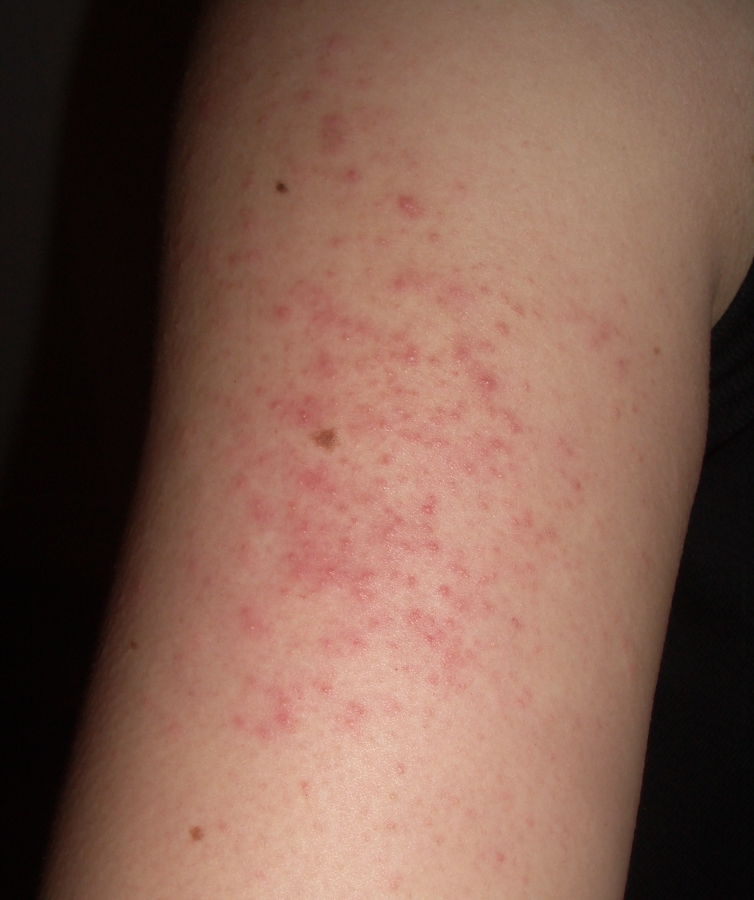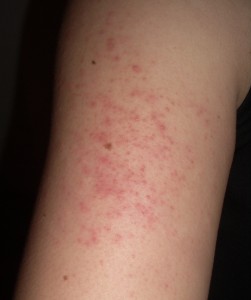
 Keratosis pilaris, also known as lichen pilaris, follicular keratosis, “KP,” or “chicken skin bumps,” is a common but harmless skin condition. It causes small acne-like bumps and rough patches that make the skin feel like sandpaper. While keratosis pilaris is not painful, some sufferers do experience mild itching.
Keratosis pilaris, also known as lichen pilaris, follicular keratosis, “KP,” or “chicken skin bumps,” is a common but harmless skin condition. It causes small acne-like bumps and rough patches that make the skin feel like sandpaper. While keratosis pilaris is not painful, some sufferers do experience mild itching.
What Causes Keratosis Pilaris?
So what is keratosis pilaris if not acne? KP is a common genetic follicular condition that occurs when a buildup of the protein, keratin, surrounds and blocks the pore of a hair follicle. This blockage causes hard plugs or bumps to form, many of which contain ingrown hair. Doctors have not until now been able to pinpoint the cause of excess buildup of keratin.
Where Does Keratosis Pilaris Appear?
These light-colored bumps can appear in many areas of the body including the thighs, arms, back, buttocks, chest, elbows, eyebrows, genitals, shoulders, and thighs, sometimes combined with swelling and redness. They may also appear on the face, but it is less common.
What is Keratosis Pilaris Video
Who Gets Keratosis Pilaris?
This skin condition affects nearly 40% of adults and roughly 50% to 80% of teenagers. It usually disappears as people grow older, improving gradually as one approaches the age of 30. However, in some cases it can persist longer. And while KP is more common in women than men, it can affect people of every race including Caucasians, African-Americans, and Asians. People with certain skin conditions such as eczema are also more prone to this skin disorder.
What Are The Types Of Keratosis Pilaris?
There are several types of “chicken skin bumps,” including keratosis pilaris rubra faceii, keratosis pilaris alba, and keratosis pilaris atrophicans faciei:
Keratosis pilaris rubra faceii manifests as a reddish rash on the face, especially the cheeks. While similar in appearance to acne, its cause is different. In rubra faceii, keratin prevents hair follicles from forcing their way through whereas acne occurs as a result of bacterial growth.
Keratosis pilaris alba is a skin defect that manifests as dry and rough bumps or patches covering the dermal skin cells.
Keratosis pilaris atrophicans faciei begins in infancy and initially affects the lateral eyebrows, before usually spreading to the forehead and cheeks.
Most doctors can diagnose these types of keratosis pilaris simply by looking at your skin without requiring additional testing.












What’s up, this weekend is nice for me, as this moment iam reading this enormous informative article here at my residence.Feel free to surf to my blog … penny stock news
Take your body weight, didive it by 2 and then take that number and drink that much water (in ounces) each day. So if you weigh 150 pounds, you should drink 75 ounces of water each day You can convert liters into ounces using google or any other type of measurement too.
I never knew what is keratosis pilaris but by the looks of it, I think my nephew has keratosis pilaris alba. He has small dry patches of skin, but only on his arms, he doesn’t have those on the legs. The good thing is he’s not bothered by it, he’s not scratching or picking the small white dots.